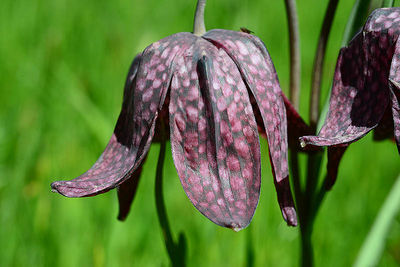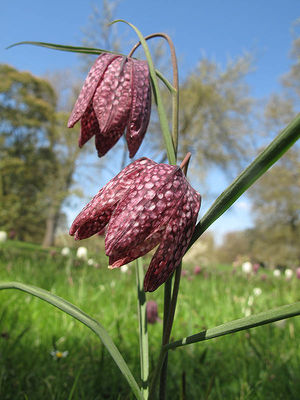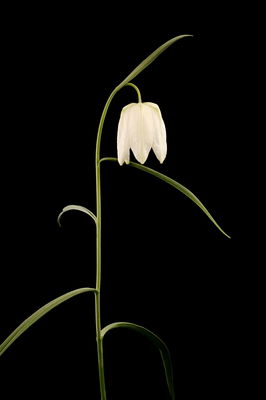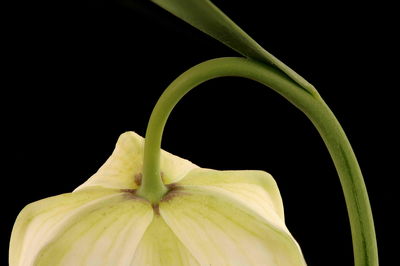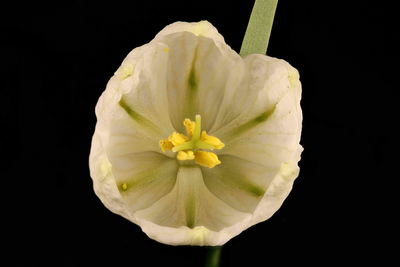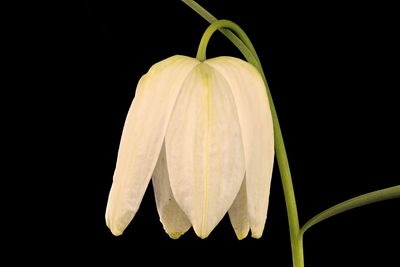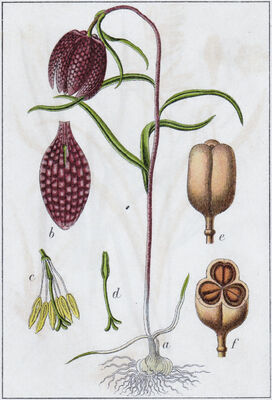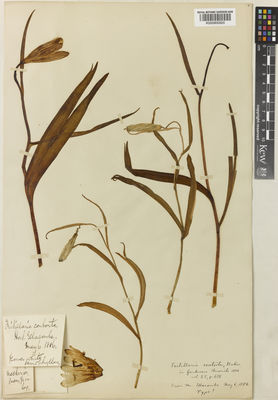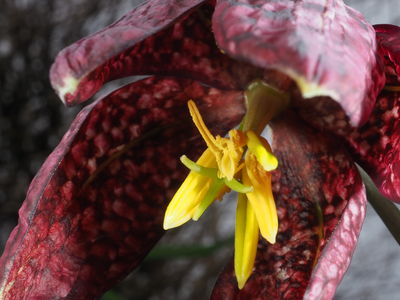Geography and distribution
Snake's head fritillary occurs in the wild from Great Britain and central Russia south to the southern Alps, western Balkans and the Altai Mountains. This species has become naturalised in Denmark, Finland, Norway, Sweden and the Baltic region. It favours damp, sometimes winter-flooded, neutral grasslands, usually those traditionally managed for hay with some grazing.
Description
Snake's head fritillary has a globose bulb with a few compressed scales covered by a thin, transparent tunic (outer coating). The flowering stem (peduncle) is 12-30 cm long and bears 4-6 linear, glaucous leaves. There is usually one pendent flower per peduncle. The perianth (petals and sepals) is very broadly (square-shouldered) bell-shaped, comprising purple, pink or white segments with a characteristic chequered purple pattern (although a white form also occurs). The green nectaries are towards the base of the inner perianth segment surfaces, and measure approximately 7-10 x 1.5 mm. The filaments are 10-13 mm long and are covered with short, rounded projections. The style is 13-16 mm long and is three-cleft, with branches 2-5 mm long. The fruit is an erect, flat-topped, 6-angled capsule (a dry and dehiscent fruit composed of more than one carpel).
Fritillaria meleagris flowers from late March to April. The flowers are hermaphrodite (having both male and female organs) and are pollinated by bees. The plant is also capable of self-fertilisation.
Subspecies
Its two subspecies can be distinguished as follows:
F. meleagris subsp.
meleagris has perianth-segments that are often white or pink, a style and filaments with short, rounded projections, and is distributed throughout the range of the species (with the exception of the Alps)
F. meleagris subsp.
burnatii has purple perianth-segments, filaments that are smooth or sparsely covered with short, rounded projections, a smooth style, and is only found in Alpine pastures in France and Italy. Threats and conservation
National assessments according to IUCN Red List criteria:
Vulnerable (VU) (Romania, Ukraine)Endangered (EN) (Hungary, Switzerland)Critically Endangered (CR) (Slovakia)Extinct (EX) (Czech Republic)
Assessed as Nationally Scarce in the UK in 2007 (according to non-IUCN criteria).
The lowland grassland habitat favoured by Fritillaria meleagris is in decline. Snake's head fritillary is considered to be extinct in the Czech Republic and threatened in Romania, the Ukraine, Hungary, Switzerland and Slovakia. F. meleagris is much less common in England than formerly, and is included in a number of English local Biodiversity Action Plans.
Uses
Snake's head fritillary has been cultivated as an ornamental in Great Britain since at least 1578 (during the Tudor period, 1485-1603), and was first discovered growing wild in 1736. Apart from obvious plantings, such as those at Kew, a good place to see fritillaries is at the famous Magdalen College Meadow in Oxford.
The English village of Ducklington (in Oxfordshire) holds a Fritillary Sunday festival; fritillaries grow in a meadow close to the village, but they were once more abundant here and elsewhere along the River Thames. Indeed, flowers were so abundant around Ducklington that they used to be picked and sent to Covent Garden flower market in London. As suitable grasslands disappeared, so too did the fritillaries, and this rural industry vanished.
Cultivation
Fritillaria meleagris is best grown in the open garden, naturalised in a grassy meadow or planted in an herbaceous border or rock garden. The bulbs should be planted in a position that is not too hot and dry in the summer. Although the bulbs are dormant at this time, they do not need to be kept completely dry, and a little moisture in the soil is beneficial, as long as it is never waterlogged. Growth begins in autumn, but little is seen above ground until late winter. At Kew, flowering usually occurs in late March or early April. A sunny or partially shaded position is best, such as under deciduous trees or shrubs or against an east or west-facing wall. Propagation is from seed sown in autumn or early winter and plants often seed nearby once a colony is established.
This species at Kew
Planted along Princess Walk at Kew, 30,000 snake's head fritillaries add colour and spectacle to the spring flowering bulb displays. They can also be seen along Riverside Walk, where they usually flower in April.
Flowering between April and May, 1,600 snake's head fritillary bulbs bring a delicate and elegant swathe of beauty to the Bog Garden at Wakehurst.
Dried and alcohol-preserved specimens of Fritillaria meleagris are held in Kew's Herbarium, where they are available to researchers from around the world, by appointment.
The details and images of some of these specimens can be seen online in the Herbarium Catalogue
Kew's work on genome size and snake's head fritillary
In flowering plants, the amount of DNA within a nucleus (often called genome size) can vary nearly 2,400-fold. Compared with our own relatively slim genome, which would stretch 2 m if all the DNA in a cell was unravelled, some bulbous monocots contain much larger genomes.
The genus Fritillaria is particularly interesting as it includes species with some of the most obese genomes so far reported in plants. Although Fritillaria meleagris does not have the largest genome, it still has an enormous amount of DNA (more than 15 times as much as humans have) and its genome would stretch over 30 m if unravelled.
In Kew's Genetics section in the Jodrell Laboratory, work is currently being undertaken to investigate how and why Fritillaria genomes have become so big. We are taking advantage of recent developments in high-throughput DNA sequencing and chromosome painting strategies to study selected Fritillaria species (including F. meleagris ) to provide insights into the dynamics and evolution of the DNA sequences which comprise the bulk of their obese genomes. This has been made possible through a three-year Natural Environment Research Council (NERC)-funded grant (2010-2013).




